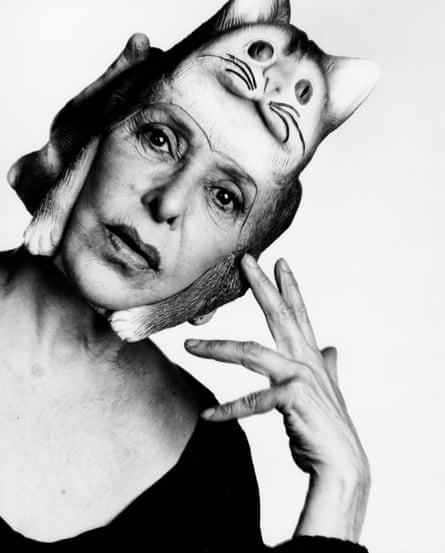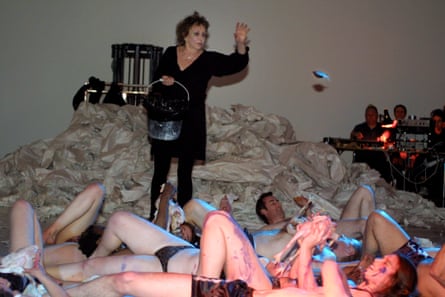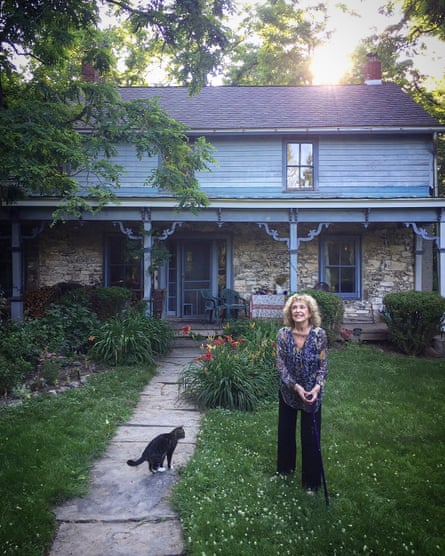It is bittersweet that the so-called global art world (still dominated by western, white and patriarchal values is finally taking note of maverick women artists, so many in their 70s, 80s and even 90s. Carolee Schneemann, who died this week aged 79, benefitted from this dynamic at the end of her life. But I know she shared my suspicion. Why now? Why not then?
Carolee spent 45 of the 60 active years of her professional career creating work with intensity and integrity, a feminist artist before the art world knew of such a thing. She shared her ardent attention to the erotics of creative living, her art summing up the intensity of her approach to friends, lovers, cats and her creative practice – all meshed into one great life work.
I first met Carolee when I was an avid newly minted feminist art historian in the mid 1990s. She invited me into her studio in Manhattan, which, filled with paintings, sketches, paint, film and other materials bound to the myriad forms of her practice, struck me as epitomising the creative space of a successful feminist artist. But the space and the art being made within it were only a small part of the thrill of the meeting. Immediately, I could feel the energy of this extraordinary woman – the lived force of her embodied expression, in everything she did.

I learned from Carolee through every meeting, phone call or email exchange. There was never a moment in which she was not “on”: thinking, moving, conveying, responding to people, ideas, materials, spaces around her. Every moment of lived experience was both creatively expressed and potential fodder for her creative intelligence. She creatively and erotically lived the work of the phenomenological philosophers I was avidly reading in the 1990s, and yet scoffed when I asked her if she had read any Merleau-Ponty, saying something like: “That was the guys’ stuff. I didn’t need to read it. I was doing it.”
In 1996, I opened my Sexual Politics exhibition at the UCLA Hammer Museum, featuring a large work of hers involving multiple photographs of her kissing her cat Vesper. When I invited her to dinner, she filled my home with her laughs and wisdom. She engaged with my three-year old son in a tender way, but was (naturally) more interested in my two cats, and what I was feeding them. She would have winced in empathetic pain (with the cats) to know that we kept feeding them canned food even after her disquisition on the benefits of cooking them fresh chicken liver. I had trouble grasping the importance of her beloved felines to her mode of creative living, even though every time I watch her film Fuses I bond in cinematic suture with the cat (I think Kitch) who allowed us to “see” Carolee and Tenney making love in the gorgeous pellucid flames. (Kitch is shown watching; we are voyeurs through Kitch’s eyes.)

A few years later, responding to an email in which I shared some text I had written about her groundbreaking feminist performance Interior Scroll – in which she reads from a scroll of paper unrolled from her vagina – she let loose, chastising me for focusing repeatedly on this key piece rather than attending to her paintings, her films and her many other more material art works. In that same email exchange, however, she also (with her habitual profound eloquence) described my work as being “in the wet delicious stuff and the hostile, delusional projective surround” of the body. Well, yes. I was in heaven.

In 2007, I invited her to speak at the yearly Performance Studies International conference – this time held in New York. She asked me to speak with her in a dialogue about a field that had not much acknowledged Carolee’s work or importance. She was the elegant, hot centre of a beautiful day. The small room was packed to overflowing; her words riveted the audience as I scrolled through images from her career, the avid attention of her listeners testament to her supreme charisma as a performer. She taught performance scholars what it means to think, make, live through the body all day long every day as a visual artist.
I spoke to Carolee on the phone last month when I was at Bard College, her alma mater, giving a talk. As was her wont, she immediately invited me to dinner (she lived, still, down the road in her old farmhouse in upstate New York). I always wanted to visit her there, and never thought I had the time. I declined her invitation, thinking that during my next visit to the New York area I would make a point of it and visit with my daughter, who is a newly minted Schneemann fan. I always wanted to write an article about Plumb Line, a lesser known Schneemann film from the late 1960s – she was waiting for that, too. Now I know. You always have the time for what really matters – the embodied connections that make life worth living. Carolee taught me that, but I didn’t listen closely enough.
